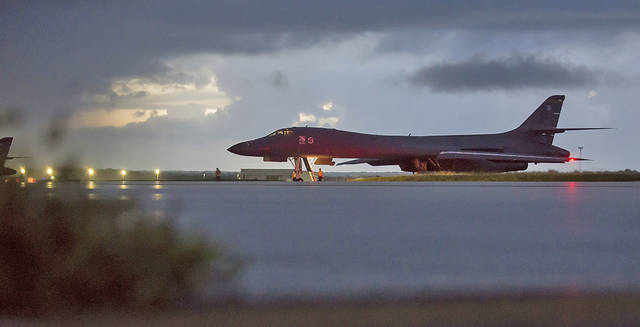WASHINGTON — In a show of American military might to North Korea, U.S. bombers and fighter escorts flew on Saturday to the farthest point north of the border between North and South Korea by any such American aircraft this century.
WASHINGTON — In a show of American military might to North Korea, U.S. bombers and fighter escorts flew on Saturday to the farthest point north of the border between North and South Korea by any such American aircraft this century. The Pentagon said the mission in international airspace showed how seriously President Donald Trump takes North Korea’s “reckless behavior.”
“This mission is a demonstration of U.S. resolve and a clear message that the president has many military options to defeat any threat,” Defense Department spokesman Dana White said in a statement.
“North Korea’s weapons program is a grave threat to the Asia-Pacific region and the entire international community. We are prepared to use the full range of military capabilities to defend the U.S. homeland and our allies,” White said.
North Korea’s leader, Kim Jong Un, has said Trump would “pay dearly” for threatening to “totally destroy” North Korea if the U.S. was forced to defend itself or its allies against a North Korean attack. Kim’s foreign minister told reporters this past week that the North’s response to Trump “could be the most powerful detonation of an H-bomb in the Pacific.”
North Korea has said it intends to build a missile capable of striking all parts of the United States with a nuclear bomb. Trump has said he won’t allow it, although the U.S. so far has not used military force to impede the North’s progress.
The Pentagon said B-1B bombers from Guam, along with F-15C Eagle fighter escorts from Okinawa, Japan, flew in international airspace over waters east of North Korea on Saturday. The U.S. characterized the flights as extending farther north of the Demilitarized Zone, than any U.S. fighter or bomber had gone off the North Korean coast in the 21st century.
B-1 bombers are no longer part of the U.S. nuclear force, but they are capable of dropping large numbers of conventional bombs.
U.S. Pacific Command would not be more specific about how many years it had been since U.S. bombers and fighters had flown that far north of the DMZ, but a spokesman, Navy Cmdr. Dave Benham, noted that this century “encompasses the period North Korea has been testing ballistic missiles and nuclear weapons.”




